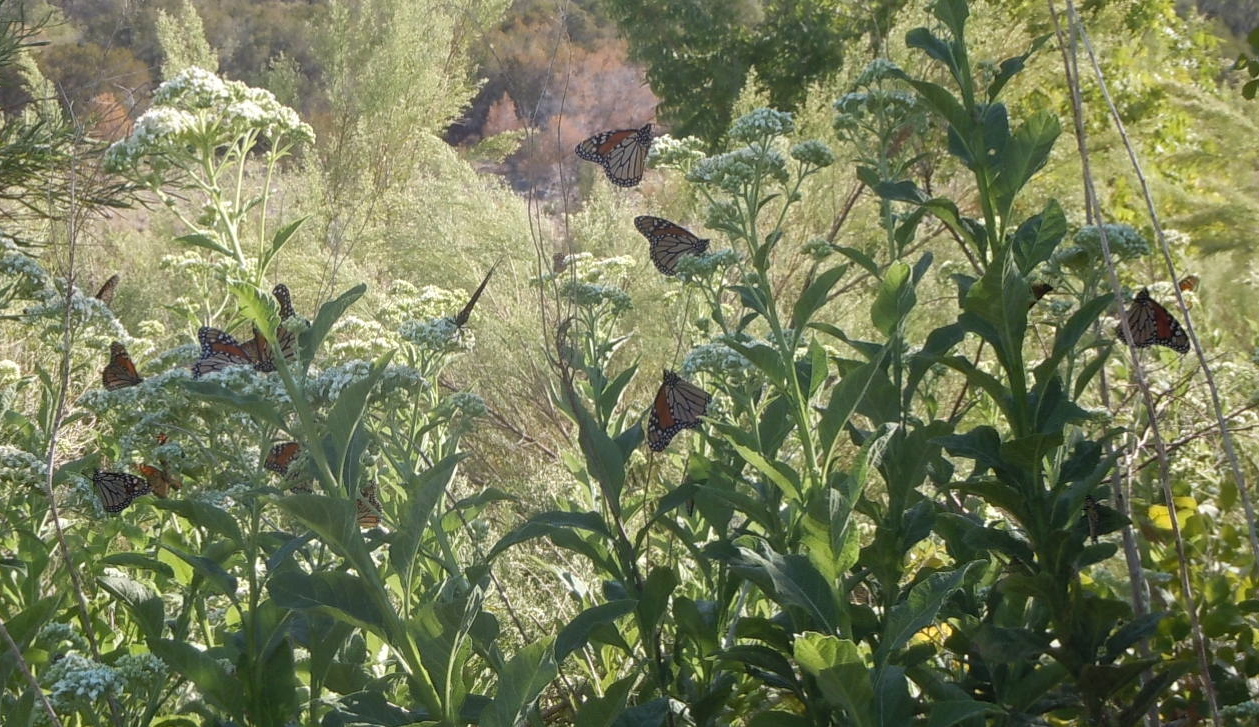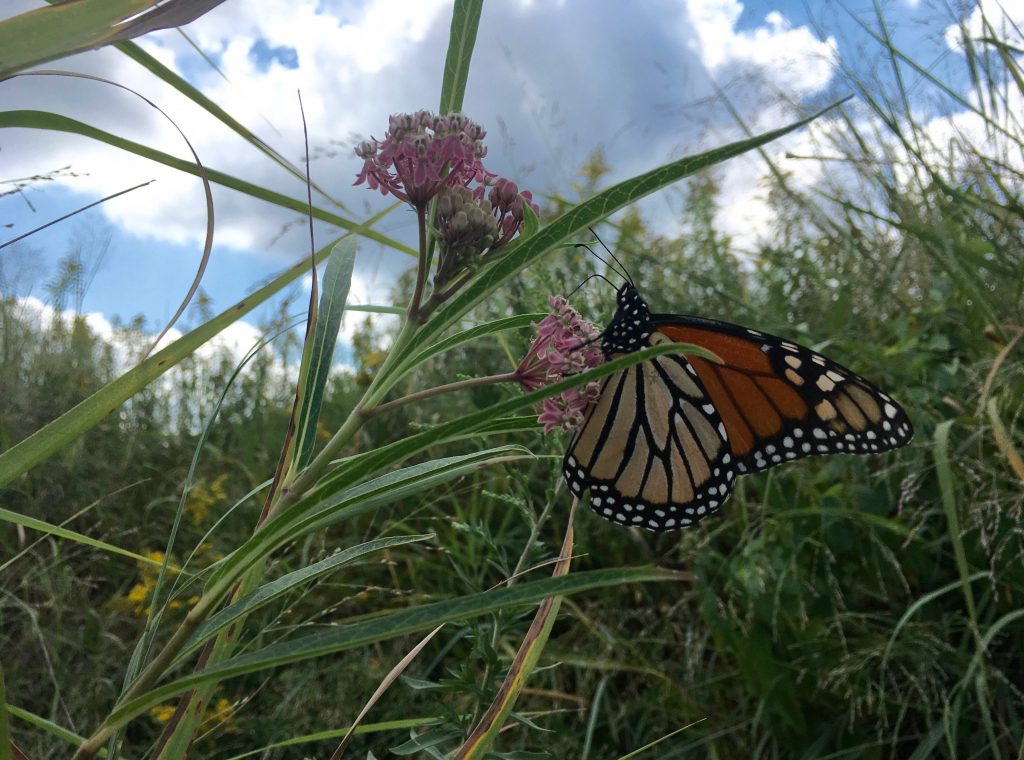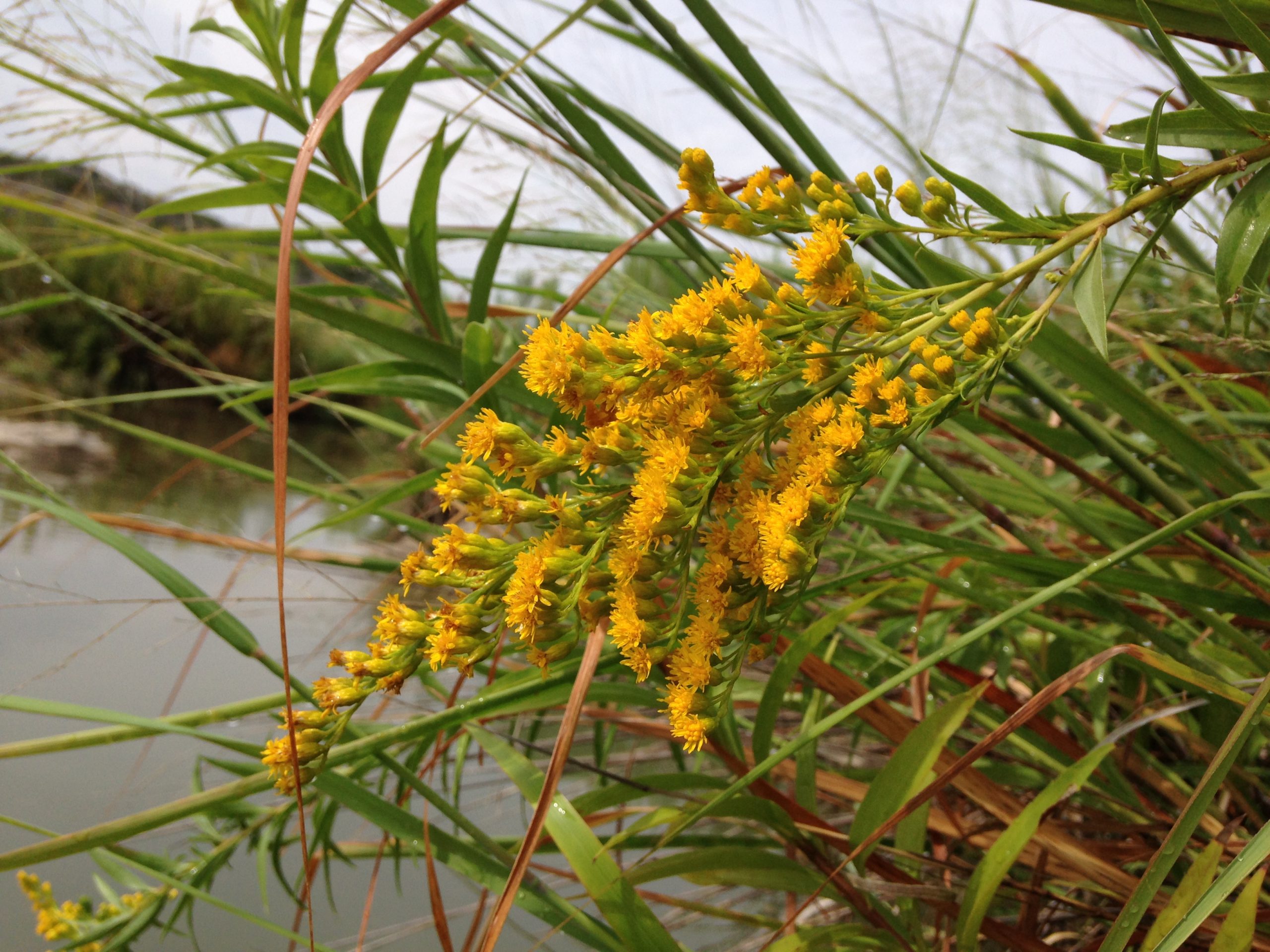A research paper published April 27 in the journal Oikos is causing a stir in the Monarch butterfly world. The paper challenges the conventional wisdom that the major cause of the decline of the Monarch butterfly migration is a lack of milkweed tied to the increased adoption of herbicide tolerant crops in the butterflies’ midwestern breeding grounds.
Anurag Agrawal and his team of researchers at Cornell University tackle this widely held assumption in their recent paper, “Linking the continental migratory cycle of the monarch butterfly to understand its population decline.” Agrawal suggests that the emphasis on milkweed may be misplaced and that solutions addressing habitat fragmentation, and most interesting and relevant to Texas, late season nectar plants should receive more attention.

Migrating Monarch butterflies nectar on Frostweed in the Texas Hill Country, October, 2011. Photo by Monika Maeckle
“Planting milkweed is probably not a bad thing to do but it’s not going to increase their population or save them from some demise,” said Agrawal in a nine-minute video titled “Beyond milkweed: Monarchs face habitat, nectar threats.” The video, below, was released in conjunction with the paper.
“Milkweed is probably not the limiting thing for the Monarch population,” he said. “Perhaps planting milkweed will not improve or increase the populations as much as we thought in the past.”
Calling the decline of the Monarch butterfly migration a “very very gnarly problem,” Agrawal gave kudos to citizen scientists for their involvement in the study and said more than once that we must “get the science right.”
“We must identify the key weak points. It is absolutely critical. If we don’t, we could be investing a lot of effort into conserving a portion of the migration but it may have ultimately no impact conserving the species overall,” he said.
Agrawal and his team matched Monarch butterfly counts made by citizen scientists and others to the different stages of the migration. After doing so, they found that counts were not down until the end of the migratory cycle, when the butterflies started heading south.
“By the time they get to Mexico, their numbers are plummeting,” said Agrawal, “but at the end of the summer, when they start that migration, their numbers are not down.”
The research underscores the different needs of the species at the different stages of their life cycle.
In early spring, as Monarchs move north through the Texas funnel, they need milkweed on which to lay the first generation of eggs. They continue to need milkweed through the summer as subsequent generations reproduce as they move north.
But in the fall when the Monarchs are heading south, they don’t need milkweed since they enter their reproductive diapause–that is, a temporary stage in which they postpone sexual activities and save their energy to migrate to Mexico. At this point, they need water, ample nectar sources, trees or other protection at night for roosting, and connected habitats.
Agrawal’s point is well taken. Immense focus has been devoted on increasing the Monarch butterfly host plant, milkweed. Milkweed, anything in the Asclepias family, is necessary in the early stages of the migration when the Monarchs are reproductive. But what about later in the game, when Monarchs are NOT reproductive? They require nectar to fuel their flight. Agrawal and his colleagues suggest that late season nectar plants and perhaps interconnected habitats–ie, pollinator corridors–would make their continuous route south more doable.
University of Georgia ecologist Andy Davis made a similar point last year when he spoke to the Washington Post. Davis challenged the idea of basing the Monarch butterfly population census on counting the number of hectares in Mexico occupied by the migrating creatures each winter.

Monarch on Swamp milkweed on the Llano River in the TExas Funnel. Photo by Monika Maeckle

Monarchs caterpillars eat only milkweed, but Monarch butterflies will nectar indiscriminately. Photo by Monika Maeckle
“If you were charged with figuring out how many people are participating in the Boston Marathon each year, you wouldn’t count the number of people who cross the finish line,” said Davis. “For many years we’ve been counting the finishing Monarchs in Mexico….We’ve been doing it backwards.”
What Agrawal says about nectar plants makes sense, especially for Texas.
Think about it: as Monarchs migrate south in the fall through the Texas funnel, they are not reproductive. Their goal during this part of the migratory cycle is to fuel up on late season nectar plants and build up their body fat so they can make it to Mexico and survive the winter. There, in early March of the following spring, they will leave their mountain roosts to mate, lay eggs on milkweed, and start the cycle all over again.
That suggests that in the fall in Texas, there really is no need for milkweed for migratory Monarchs. In fact, one could argue (and many scientists have) that having milkweed available late in the season will encourage Monarchs to break their diapause and reproduce, thus never arriving in Mexico. This also suggests what Monarchs DO need in the fall: late season nectar sources.
The point is important and timely, given that millions of dollars in conservation funding and grants are being awarded as we speak. Should those grants and initiatives be focused on cultivating more milkweed or developing more sources and locations for late season nectar plants?
In much of Texas, called “the most important state” to the migration by Chip Taylor of Monarch Watch and others, the fall garden trumps the abbreviated spring garden season. Temperatures climb into triple digits so early here that it’s challenging to grow many fruits, vegetables and flowers until the fall when things cool off. In such a context, and given the timing of the Monarchs arrival here in the fall, late season perennial blooming plants should be encouraged. We are well-suited to provide them.

Monarch nectaring on Duranta at Texas Butterfly Ranch urban butterfly garden, downtown San Antonio, November 2015. Photo by Monika Maeckle

Goldenrod, a favorite nectar source for Monarch butterflies during the fall migration, awaits on the Llano River in the Texas Hill Country. Photo by Monika Maeckle
Need ideas? Try Goldenrod, Frostweed, Autumn sage, Late flowering boneset, Asters, Cowpen daisy in your fall garden if you want to help Monarchs. In my downtown San Antonio butterfly garden last year, Duranta, sometimes called Brazilian skyflower, was a big draw for Monarchs and other pollinators. It’s not native, but a well adapted flowering bush–and highly appropriate, fantastic plant.
Monarch Watch offers this super useful list of appropriate nectar plants by season. The Xerces Society also has a guide for useful pollinator friendly plants. And the Pollinator Partnership offers plant guides for every region in the country.
Scientists will continue this debate. Chip Taylor recently took Agrawal’s paper to task in a rebuttal paper, “Conclusion of No Decline in Summer Monarch Population Not Supported” and Davis rebutted the rebuttal on his highly educational Monarch science blog.
Meanwhile, those of us in Texas should plan and plant late season bloomers. Doing so will offer the bonus of providing fuel and sustenance not only for Monarchs but other pollinators.
Related Articles
- How to plan a successful butterfly and pollinator garden
- Mostly native butterfly garden outperforms lawn every time
- A year in the life of an urban butterfly garden
- Downtown River walk plot converts to pollinator garden, creature haven
- Converting your Lawn to a Butterfly Garden
- San Antonio becomes first National Wildlife Federation Monarch Champion city
- Late season Monarchs create gardening quandary
- What to do with late season Monarchs
- Tropical Milkweed: To Plant it or Not is No Simple Question
- How to raise Eastern Swallowtails
- How to raise Monarch butterflies at home
Like what you’re reading? Don’t miss a single article from the Texas Butterfly Ranch. Sign up for email delivery at the bottom of this page, like us on Facebook, follow us on Twitter, @monikam or on Instagram.

This is the exact problem I have noticed for the past few years in my own flower garden. I live in the western piedmont area of NC. I only see Monarchs in my own area very late September to the first half of October. By then, most of my nectar producing flowers are gone. So far, I have been unable to turn up late-blooming flowers that would appeal to the few Monarchs I have migrating through my area at that time. I have Butterfly bushes they like, but even their blooms are winding down that late in the season. Any flower suggestions would greatly be appreciated!
Sharon, check out the plant list resources in the third to last graf of the story. Thanks for writing, and good luck! –MM
Thank you!! Totally missed this!
I have a Monarch Way Station in Northwestern Minnesota. Late fall when the Monarch migration came through I still had late blooming flowers but the monarchs exclusively went to the blooming purple flowers of plumless thistle and only the thistle. I now have new respect for thistle, though I still attempt to rid the area of the Canadian thistle which will crowd out most other plants.
Don, are these Canada Thistles? If so, the monarchs in Minnesota sure do like their nectar: https://youtu.be/ckNudPFvg3w
Paul, I wanted to get your opinion on the reason for the monarch population spike in 1995-96. As shown on the USDA link below cropland has been about the same acreage since 1910. Increase in herbicide has been more per acre not more acreage. The only major drought since the population has been counted is the 2010-13 at the link below contributed to the low 2013-14 numbers. Most everything else has been constant. I thought maybe it was a super population like the admirals, snouts, and this year painted ladies or maybe it was an exaggeration by the counters. What do you think ?
https://en.m.wikipedia.org/wiki/2010%E2%80%9313_Southern_United_States_and_Mexico_drought
https://www.ers.usda.gov/data-products/major-land-uses/
So I guess the indians planted wildflowers for them in the fall before the 1400’s and whitey dropped the ball after he killed all the indians right ?????
I have Aphids and a couple of other bugs or leaf infestation on all of my Milkweed plants. At the same time I have lots of eggs and a few cats, so can’t spray with any kind of insecticide. Am going to nursery tomorrow with sampling of leaves to get advice, but even the brand new plants have something on them that turns the leaves kind of brown. I am almost ready to throw out all my plants & not do this anymore. Last season I buried at least 6 b-flys. So sad,
The authors of this of this study didn’t actually go into the field in west-central Texas and Oklahoma and determine whether monarchs aren’t finding enough nectar or water to drink as they travel long distances. I visited west-central Texas and Oklahoma during the ultra severe drought in early Oct. 2011 and video documented that the millions of monarchs moving through were not showing much interest in nectaring or water drinking:
Sonora, Texas, Oct. 4, 2011:
https://www.youtube.com/watch?v=BVmB04qbSmw
https://www.youtube.com/watch?v=Ub-BdQbV4OE
Del Rio, Texas: Oct. 3, 2011:
https://www.youtube.com/watch?v=rTpbzu9B1G0
Del Rio, Texas: Oct. 4, 2011:
https://www.youtube.com/watch?v=ZebZQ3GJO54
https://www.youtube.com/watch?v=bO-b1JwDVUM
Good stuff Paul ! One example of a fall blooming wild nectar plant is liatrius. This is one of the most popular It has a 16 foot taproot. I’ve never seen it not bloom !
This is something I’ve wondered about since I first started growing milkweed. The slogans “Got Milkweed” and “Plant milkweed and they will come” always seemed lacking.
What we need to remember that often, in a garden where a person is either providing milkweed in a safe area, or bringing the Monarch caterpillars in to raise, more caterpillars become butterflies. So for every milkweed you plant, you ideally should be providing 2 nectar plants. And an attempt should be made to have nectar flowers blooming from early spring through late fall, early winter. I think this need for butterfly sustenance in the form of nectar plants has been overlooked.
All milkweeds ARE nectar plants as well as host plants 😉
Thank you! That was my first thought just seeing the title of this article. Milkweed is both a host AND nectar plant. Ive got a mix of different host and nectar plants but milkweed is one that fulfills both roles.
My caterpillars are in my butterfly screened cage. Spiders. I believe, are killing them when they are in the cocoon stage. When the cocoon turned brown, today, I loosed it and put it into a plastic bowl…with a mesh screen over it tightly. When the butterfly emerges, soon, I will put it into the cage for a short time, then release it…..San Diego area.
I live in Houston area. I Started planting milkweed a few years ago and have plenty of Monarchs. This year it seems that the eggs hatch put when the caterpillars are small some insect picks them off. I’ve seen wasps lurking around the milkweeds. Does anyone else have that problem and how do I control it?
Numbers as high as 99% of monarch eggs never reach the ” in Flight” stage especially in the southern region because of fire ants, wasps etc. 10s of thousands of butterfly enthusiasts across the North American range of monarchs are realizing this and are predator protected rearing monarchs until in flight and releasing them. There is an abundance of milkweed unused by monarchs allowing for tremendous increases in populations. I suggest observing and learning about these efforts on Facebook pages such as “The Beautiful Monarch” and “Monarchs and Milkweeds” Other than favorable weather conditions for monarch habitat, this is the only logical method to raise butterfly populations. You will find out there’s a large national movement towards this. I hope you will join this movement and encourage your friends to do the same.
As was mentioned in a previous comment Milkweed is both a nectar and a host plant. This article has no validity.
Yeah but it is not a late season blooming plant that the butterflies need during migration. The milkweeds are pretty much finished flowering before the southward migration starts. In the late summer and fall the butterflies rely on late blooming plants such as goldenrods, asters and blazingstars.
I have large plantings of Salvia farinacea and Greg blue mist flower that the monarchs ate very attracted to in the fall. Two years ago I had no less than 50 monarchs a day from the end of September to the 1st of November. Last year not do many. I have planted more Ferinacea with high hopes to draw more to my Fort Worth garden at the rock house. Anyone is welcome to come and take a look.
I’ve never seen any nectar plant attract more monarchs and especially queens than blue greggs mist. I’ve been hoping thay would plant a lot of it on the Riverwalk. Be carefull it spreads rapidly and if you have to mess with it weed eat the spent blooms on half the plant at a time to keep the blooms coming. It’s a great plant for fall nectar.
I don’t know about nectar producing capacity, but in my tiny garden the tall Zinnias win hands down as the biggest fall attractant of butterflies.
I see that this post is old, but I’m hoping some of you in the group might have some good answers for me. I’m publishing a children’s book on monarchs. For the spread on the northern migration from the overwintering sites in spring, I’d like to know what good nectar flowers are among the first they come across in northern Mexico and southern Texas, Alabama, Louisiana? It’s important to plant with that last chapter of the migration in mind, as well.
We have lots of zinnia and lantana in coastal Mississippi.
Thank you!
I found a Monarch chrysalis hanging from my zucchini plant in my garden. I do companion planting and had a lot of zinnias, sunflowers, cosmos, and other wild flowers amongst the vegetables. The monarchs fed on the sunflowers the most but also fed on many of the other flowers. I got my garden in late so the sunflowers were blooming past the time others in my area had had theirs already gone to seed. I live in Central Iowa. I cut the branch of the plant it was on and put it in a safe place til the butterfly hatched.
I left it alone to let it do it’s thing and it was gone by the next morning. I hope it had a safe journey.
The numbers of monarchs killed by cars on their trek north then back south each year must be staggering! Too bad there isn’t something like the deer whistles we have on the front of our cars to warn the on coming deer on the side of the road.
[…] (Chlosyne nycteis) and bordered patch butterflies (Chlosyne lacinia). In addition, frostweed is a notably important nectar plant for Monarch butterflies in the Fall as they head south to their wintering grounds in […]
[…] (Chlosyne nycteis) and bordered patch butterflies (Chlosyne lacinia). In addition, frostweed is a notably important nectar plant for Monarch butterflies in the Fall as they head south to their wintering grounds in […]